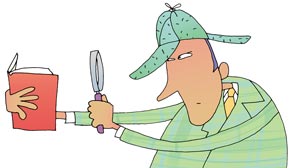
My freshmen recently turned in a lengthy inquiry project. They had been working on it for weeks, and it was thrilling to see their research and writing take its final form. I was particularly excited to review one student’s exploration of a historic neighborhood. And indeed her work was engaging, insightful, and well-researched.
There was an issue, though. The project included erratic capitalization and numerous misspelled words. Reflecting on this, I realize I should have done a better job of preparing her and the rest of the class to edit their final drafts.
In my writing classroom, I tend to project a relaxed attitude toward grammar and correctness. I want my students to write freely and revise bravely without having to worry about getting every word, every mark, and every decision right. When giving feedback on drafts, I focus on higher-order writing priorities—such as the ideas, organization, and voice—rather than grammar and mechanics. This was the case when I conferred with this particular student about her project.
I assumed she would edit before submitting or, at a minimum, let her spell checker work its magic. I was wrong. I shouldn’t have assumed that my students have the same editing habits that I do.
Let’s take a look at what I could have done to instill better editing habits.
1. Reiterate the purpose of editing.
Editing is the process of checking writing line by line for errors, both at the sentence level and the word level. When students edit, they should focus on punctuation, spelling, capitalization, grammar, and other conventions.
2. Reiterate the importance of editing.
Editing can be tedious work, but the payoff is worth the effort. Editing ensures the writing ideas come across clearly to readers. For the student mentioned above, misspelled words and erratic capitalization diverted attention from otherwise tremendous work. A simple editing pass would have helped her catch and correct the most distracting errors.
3. Recommend when to edit.
Students should reserve time at the very end of their writing process for editing. That way they can catch any errors they may have made when drafting and revising.
4. Introduce editing strategies.
Students can follow these best practices in editing:
- Edit with fresh eyes. Taking a break from the writing (the longer the better) will help students view their work with fresh eyes.
- Read the writing slowly. Editing is a practice of close reading.
- Read the writing aloud. This is my personal favorite editing trick. Reading out loud helps students hear the mistakes—like missing words—that they may have skipped over or corrected subconsciously while reading silently.
- Use an editing checklist. Checklists break down the process of editing into manageable tasks. By following checklist items, students can concentrate on one convention at a time. (See more in the featured download.)
- Utilize editing resources. Students should have a dictionary and a writing handbook close by for questions about punctuation, capitalization, spelling, and grammar.
- Get help from another reader. Students can have a peer check their writing for conventions.
5. Model and practice editing strategies.
Students benefit from seeing editing in action and practicing the same techniques. Practice activities from a SkillsBook or online grammar unit will introduce specific skills, but it is crucial that students also apply the skills to their own writing. The following activity can help.
Featured Download: Build Your Own Editing Checklist
You can adapt the following activity to help students of all ages edit their writing.
Teacher Support
Consider this support for the activity.
Levels
3–12
Learning Objectives
- Practice close reading and careful editing.
- Develop habits of effective editing.
- Demonstrate awareness of the conventions of capitalization, punctuation, and spelling.
- Demonstrate awareness of the conventions of grammar, sentences, and usage.
Teaching Tips
- To drive home the importance of editing, relate the topic to something familiar, such as fashion. Here's an analogy I like to use:
If you’re going to a fancy wedding, people will expect you to wear clean, well-put together clothes. If you show up with a tiny smudge on your shirt, guests might not notice. But if ketchup stains are splattered across your white shirt, you’re going to receive some odd looks and unwanted attention. Editing removes stains from writing. When you take the time to carefully reread and edit your writing, you may not clear up each and every smudge, but you will remove the glaring stains that can reflect poorly on you and cause readers confusion.
- In the featured activity, change the checklist options to meet the needs of your learners. For younger students, keep the checklist simple. Add items as the writers grow in skill level.
- To help students prepare for on-demand writing tests, discuss quick, simple editing strategies, such as double-checking all names and numbers.
- Need more support? All of Thoughtful Learning's writing handbooks include chapters on editing as well as a comprehensive proofreader's section devoted to marking punctuation, checking mechanics, improving spelling, using the right word, using parts of speech, and understanding sentences. SkillsBooks and online grammar units reinforce editing skills with lessons and practice activities.
